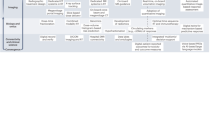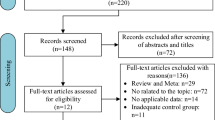Abstract
Intensity-modulated radiation therapy (IMRT) is a novel form of radiotherapy, which has the potential to reduce the amount of radiation unintentionally delivered to normal tissues while maintaining a high radiation dose to the tumor in comparison with standard radiation techniques. In adults, this technology has been implemented in a number of tumor sites, but in children it has been little used. This article will review the current studies in which IMRT has been used in children. It will also discuss possible future applications for IMRT, and anticipated problems with its use.
This is a preview of subscription content, access via your institution
Access options
Subscribe to this journal
Receive 12 print issues and online access
$209.00 per year
only $17.42 per issue
Buy this article
- Purchase on Springer Link
- Instant access to full article PDF
Prices may be subject to local taxes which are calculated during checkout
Similar content being viewed by others
References
Taylor RE (1996) Cancer in children: radiotherapeutic approaches. Br Med Bull 52: 873–886
Teh BS et al. (2002) Intensity modulated radiotherapy (IMRT) decreases treatment-related morbidity and potentially enhances tumor control. Cancer Invest 20: 437–451
Taylor RE (2003) Proton radiotherapy for paediatric tumors: potential areas for clinical research. Clin Oncol (R Coll Radiol) 15: S32–S36
Jannoun L and Bloom HJ (1990) Long-term psychological effects in children treated for intracranial tumors. Int J Radiat Oncol Biol Phys 18: 747–753
Willman KY et al. (1994) Radiation induced height impairment in pediatric Hodgkin's disease. Int J Radiat Oncol Biol Phys 28: 85–92
Smith GR et al. (1998) Long-term renal function in patients with irradiated bilateral Wilms tumor: National Wilms' Tumor Study Group. Am J Clin Oncol 21: 58–63
Ludin A and Macklis RM (2000) Radiotherapy for pediatric genitourinary tumors. Its role and long-term consequences. Urol Clin of North Am 27: 553–562
Paulino AC and Skwarchuk M (2002) Intensity-modulated radiation therapy in the treatment of children. Med Dosim 27: 115–120
Huang E et al. (2002) Intensity-modulated radiation therapy for pediatric medulloblastoma: early report on the reduction of ototoxicity. Int J Radiat Oncol Biol Phys 52: 599–605
Kuppersmith RB et al. (2000) The use of intensity modulated radiotherapy for the treatment of extensive and recurrent juvenile angiofibroma. Int J Pediatr Otorhinolaryngol 52: 261–268
Cummings BJ et al. (1984) Primary radiation therapy for juvenile nasopharyngeal angiofibroma. Laryngoscope 94: 1599–1605
Milanovic D et al. (2004) Intensity modulated radiotherapy (IMRT) of head and neck tumors. Increased biological effectiveness in high-risk situations by “integrated boost” therapy. HNO 52: 729–736
Pickett B et al. (1999) Static field intensity modulation to treat a dominant intra-prostatic lesion to 90 Gy compared to seven field 3-dimensional radiotherapy. Int J Radiat Oncol Biol Phys 44: 921–929
Al-Ghazi M et al. (2001) The University of California, Irvine experience with tomotherapy using the Peacock system. Med Dosim 26: 17–27
Cozzi L et al. (2004) Three-dimensional conformal vs. intensity-modulated radiotherapy in head-and-neck cancer patients: comparative analysis of dosimetric and technical parameters. Int J Radiat Oncol Biol Phys 58: 617–624
Milker-Zabel S et al. (2003) Clinical results of retreatment of vertebral bone metastases by stereotactic conformal radiotherapy and intensity-modulated radiotherapy. Int J Radiat Oncol Biol Phys 55: 162–167
Butler EB et al. (1999) Smart (simultaneous modulated accelerated radiation therapy) boost: a new accelerated fractionation schedule for the treatment of head and neck cancer with intensity modulated radiotherapy. Int J Radiat Oncol Biol Phys 45: 21–32
Fukunaga-Johnson N et al. (1998) Patterns of failure following treatment for medulloblastoma: is it necessary to treat the entire posterior fossa? Int J Radiat Oncol Biol Phys 42: 143–146
[no author] (online 1991) ICRP Publication 60: 1990 Radiation and your patient: a guide for medical practioners [http://www.icrp.org/docs/Rad_for_GP_for_web.pdf] (accessed 26 July 2004)
Followill D et al. (1997) Estimates of whole-body dose equivalent produced by beam intensity modulated conformal therapy. Int J Radiat Oncol Biol Phys 38: 667–672
Grant W III (1996) Experience with intensity modulated beam delivery. In: Teletherapy: Present and Future, 793–803 (Eds Palta J and Mackie TR) Madison: Advanced Medical Publishing
Mutic S et al. (2001) Room shielding for intensity-modulated radiation therapy treatment facilities. Int J Radiat Oncol Biol Phys 50: 239–246
Koshy M et al. (2004) Extra-target doses in children receiving multileaf collimator (MLC) based intensity modulated radiation therapy (IMRT). Pediatr Blood Cancer 42: 626–630
Slosarek K et al. (2004) Pitfalls in IMRT treatment planning with the CadPlan–Helios system. Med Dosim 29: 179–183
Saw CB et al. (2001) Immobilization devices for intensity-modulated radiation therapy (IMRT). Med Dosim 26: 71–77
Keidan I et al. (2004) Children undergoing repeated exposures for radiation therapy do not develop tolerance to propofol: clinical and bispectral index data. Anesthesiology 100: 251–254
Seiler G et al. (2001) Evaluation of the safety and efficacy of repeated sedations for the radiotherapy of young children with cancer: a prospective study of 1033 consecutive sedations. Int J Radiat Oncol Biol Phys 49: 771–783
Scheiber G et al. (1996) Deep sedation with propofol in preschool children undergoing radiation therapy. Paediatr Anaesth 6: 209–213
Fortney JT et al. (1999) Anesthesia for pediatric external beam radiation therapy. Int J Radiat Oncol Biol Phys 44: 587–591
St Clair WH et al. (2004) Advantage of protons compared to conventional X-ray or IMRT in the treatment of a pediatric patient with medulloblastoma. Int J Radiat Oncol Biol Phys 58: 727–734
Swift P (2002) Novel techniques in the delivery of radiation in pediatric oncology. Pediatr Clin North Am 49: 1107–1129
Krasin MJ et al. (2004) Intensity-modulated radiation therapy for children with intraocular retinoblastoma: potential sparing of the bony orbit. Clin Oncol (R Coll Radiol) 16: 215–222
Acknowledgements
This review was compiled as part of an IMRT fellowship at the Toronto-Sunnybrook Regional Cancer Centre, Toronto, Canada.
Author information
Authors and Affiliations
Corresponding author
Ethics declarations
Competing interests
The authors declare no competing financial interests.
Rights and permissions
About this article
Cite this article
Rembielak, A., Woo, T. Intensity-modulated radiation therapy for the treatment of pediatric cancer patients. Nat Rev Clin Oncol 2, 211–217 (2005). https://doi.org/10.1038/ncponc0139
Received:
Accepted:
Issue Date:
DOI: https://doi.org/10.1038/ncponc0139
This article is cited by
-
Pelvic Ewing sarcomas
Strahlentherapie und Onkologie (2013)
-
Intensity modulated radiotherapy (IMRT) in the treatment of children and Adolescents - a single institution's experience and a review of the literature
Radiation Oncology (2009)
-
On the performances of Intensity Modulated Protons, RapidArc and Helical Tomotherapy for selected paediatric cases
Radiation Oncology (2009)
-
On the performances of different IMRT treatment planning systems for selected paediatric cases
Radiation Oncology (2007)



